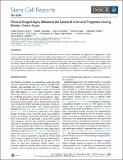| dc.contributor.author | Schäfer, Frank-Mattias | en_US |
| dc.contributor.author | Algarrahi, Khalid | en_US |
| dc.contributor.author | Savarino, Alyssa | en_US |
| dc.contributor.author | Yang, Xuehui | en_US |
| dc.contributor.author | Seager, Catherine | en_US |
| dc.contributor.author | Franck, Debra | en_US |
| dc.contributor.author | Costa, Kyle | en_US |
| dc.contributor.author | Liu, Shanshan | en_US |
| dc.contributor.author | Logvinenko, Tanya | en_US |
| dc.contributor.author | Adam, Rosalyn | en_US |
| dc.contributor.author | Mauney, Joshua R. | en_US |
| dc.date.accessioned | 2018-02-26T20:38:46Z | |
| dc.date.issued | 2017 | en_US |
| dc.identifier.citation | Schäfer, F., K. Algarrahi, A. Savarino, X. Yang, C. Seager, D. Franck, K. Costa, et al. 2017. “Mode of Surgical Injury Influences the Source of Urothelial Progenitors during Bladder Defect Repair.” Stem Cell Reports 9 (6): 2005-2017. doi:10.1016/j.stemcr.2017.10.025. http://dx.doi.org/10.1016/j.stemcr.2017.10.025. | en |
| dc.identifier.issn | | en |
| dc.identifier.uri | http://nrs.harvard.edu/urn-3:HUL.InstRepos:34868772 | |
| dc.description.abstract | Summary The bladder urothelium functions as a urine-blood barrier and consists of basal, intermediate, and superficial cell populations. Reconstructive procedures such as augmentation cystoplasty and focal mucosal resection involve localized surgical damage to the bladder wall whereby focal segments of the urothelium and underlying submucosa are respectively removed or replaced and regeneration ensues. We demonstrate using lineage-tracing systems that urothelial regeneration following augmentation cystoplasty with acellular grafts exclusively depends on host keratin 5-expressing basal cells to repopulate all lineages of the de novo urothelium at implant sites. Conversely, repair of focal mucosal defects not only employs this mechanism, but in parallel host intermediate cell daughters expressing uroplakin 2 give rise to themselves and are also contributors to superficial cells in neotissues. These results highlight the diversity of urothelial regenerative responses to surgical injury and may lead to advancements in bladder tissue engineering approaches. | en |
| dc.language.iso | en_US | en |
| dc.publisher | Elsevier | en |
| dc.relation.isversionof | doi:10.1016/j.stemcr.2017.10.025 | en |
| dc.relation.hasversion | http://www.ncbi.nlm.nih.gov/pmc/articles/PMC5785709/pdf/ | en |
| dash.license | LAA | en_US |
| dc.subject | bladder | en |
| dc.subject | tissue engineering | en |
| dc.subject | progenitor | en |
| dc.subject | urothelium | en |
| dc.title | Mode of Surgical Injury Influences the Source of Urothelial Progenitors during Bladder Defect Repair | en |
| dc.type | Journal Article | en_US |
| dc.description.version | Version of Record | en |
| dc.relation.journal | Stem Cell Reports | en |
| dash.depositing.author | Seager, Catherine | en_US |
| dc.date.available | 2018-02-26T20:38:46Z | |
| dc.identifier.doi | 10.1016/j.stemcr.2017.10.025 | * |
| dash.authorsordered | false | |
| dash.contributor.affiliated | Logvinenko, Tanya | |
| dash.contributor.affiliated | Seager, Catherine | |
| dash.contributor.affiliated | Adam, Rosalyn | |
| dash.contributor.affiliated | Mauney, Joshua | |


